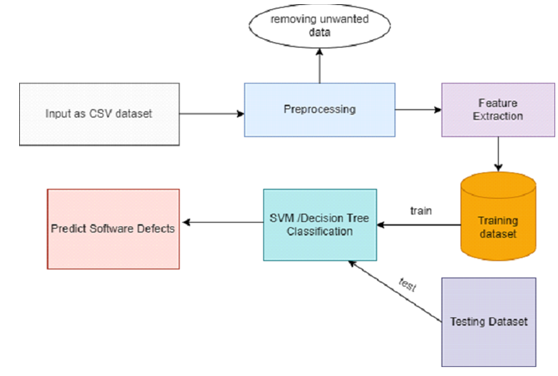Study on Software Defect Prediction Based on SVM and Decision Tree Algorithm
Main Article Content
Abstract
Software Defect Prediction is a process of identifying the potential defects in software systems before they occur. In this approach, the dataset containing information about software attributes is used as input, and the output is the prediction of whether the software is defective or not. The input dataset is generally in the form of a CSV file, which contains various software attributes such as cyclomatic complexity, essential complexity, Design Complexity, etc. The output of the defect prediction is binary classification. It is done by using SVM (Support Vector Machine) and a decision tree algorithm. This approach can help software developers identify their systems' defects before they cause any harm or affect the system’s performance.
Article Details
References
Barr, E. T., Harman, M., & McMinn, P. (2015). A comparative study of bug prediction approaches. Proceedings of the 2015 IEEE/ACM 37th IEEE International Conference on Software Engineering, 1-11.
Shen, H., Huang, J., & Zhang, H. (2006). Defect prediction using a Bayesian belief network. In International Conference on Computational Science and Its Applications (pp. 857-865). Springer, Berlin, Heidelberg.
Menzies, T., Greenwald, J., & Frank, A. (2007). A systematic review of software defect prediction studies. Information and Software Technology, 49(4), 297-310.
Nagappan, N., Ball, T., & Zeller, A. (2006). A Comparison of Machine Learning Techniques for Bug Prediction. In Proceedings of the International Conference on Software Engineering (ICSE), Shanghai, China, 675-684.
Dr. Sandip Kadam. (2014). An Experimental Analysis on performance of Content Management Tools in an Organization. International Journal of New Practices in Management and Engineering, 3(02), 01 - 07. Retrieved from http://ijnpme.org/index.php/IJNPME/article/view/27
Xia, X., Zhang, T., & Lo, D. (2014). An Empirical Study of the Effects of Bug Report Fields on Bug Fixing Time. IEEE Transactions on Software Engineering, 40(4), 373-390. doi: 10.1109/TSE.2013.47
Lessmann, S., Baesens, B., & Mues, C. (2008). An empirical evaluation of classifier ensembles for software defect prediction. Information and Software Technology,50(5),462475.doi:10.1016/j.infsof.2007.09.005
Zhou, Y., Zhang, H., & Kim, S. (2006). A Study of the Relationships between Bug-Fixing Time and Bug-Finding Techniques. Proceedings of the 28th International Conference on Software Engineering (ICSE'06), 943946.
doi:10.1145/1134285.1134459
Ernst, M. D., Cockrell, J., & Griswold, W. G. (2003). A Comparative Study of Static Analysis Tools for Bug Finding. Proceedings of the ACM SIGSOFT International Symposium on Software Testing and Analysis (ISSTA'03), 1-11. doi: 10.1145/859563.859581
El Emam, K., Melo, W., & Cruz, P. L. S. (2001). Prediction of Fault-proneness with Object-oriented Metrics – A Comparative Study. Journal of Systems and Software, 56(3), 275-286. doi: 10.1016/S0164-1212(00)00132-5
Miller, J., Evans, A., Martinez, J., Perez, A., & Silva, D. Predictive Maintenance in Engineering Facilities: A Machine Learning Approach. Kuwait Journal of Machine Learning, 1(2). Retrieved from http://kuwaitjournals.com/index.php/kjml/article/view/113
Kamei, Y., Matsumoto, S., & Nakakoji, K. (2010). Software Defect Prediction using Classifier Ensemble Selection. Proceedings of the IEEE/ACM International Conference on Automated Software Engineering (ASE'10), 23-32. doi: 10.1145/1858996.1859001
Ernst, M. D., Cockrell, J., & Griswold, W. G. (2004). A Comparative Study of Static Analysis Tools for Bug Finding in Java. Proceedings of the ACM SIGPLAN Conference on Object-Oriented Programming, Systems, Languages, and Applications (OOPSLA'04), 1-15. doi: 10.1145/1028976.1028978
Harman, M., Jones, B., & Shepperd, M. J. (2001). On the application of genetic algorithms to software engineering: A survey. IEEE Transactions on Evolutionary Computation, 5(2), 97-116.
Subramanyam, J., & Krishnan, S. (2003). Empirical validation of object-oriented metrics on open-source software for fault prediction. IEEE Transactions on Software Engineering, 29(8), 697-708.
Harman, M., Jones, B. F., & Zhang, Y. (2012). Using Evolutionary Algorithms to Improve Software Quality. Communications of the ACM, 55(7), 68-76. doi: 10.1145/2209249.2209269
Singh, A. ., & Kumar, V. . (2023). Sentiment Analysis of Customer Satisfaction Towards Repurchase Intension and the Word-Of-Mouth Advertising in Online Shopping Behavior Using Regression Analysis and Statistical Computing Techniques. International Journal of Intelligent Systems and Applications in Engineering, 11(2s), 45–51. Retrieved from https://ijisae.org
El Emam, K., & Benlarbi, S. (2001). A comparison of the predictive power of object-oriented and procedure-oriented design metrics for fault prediction. IEEE Transactions on Software Engineering, 27(7), 677-686. doi: 10.1109/32.946966
Mockus, A., Fielding, R. T., & Herbsleb, J. D. (2000). A study of the characteristics of bugs. In Proceedings of the 2000 International Conference on Software Engineering (pp. 294-301). ACM. doi: 10.1145/337180.337209
Sahoo, D. K. . (2021). Improved Routing and Secure Data Transmission in Mobile Adhoc Networks Using Trust Based Efficient Randomized Multicast Protocol. Research Journal of Computer Systems and Engineering, 2(2), 06:11. Retrieved from https://technicaljournals.org/RJCSE/index.php/journal/article/view/25
Panichella, S., Di Sorbo, A., & Visaggio, C. A. (2016). BugNet: continuously mining distributed bug reports. In Proceedings of the 38th International Conference on Software Engineering (pp. 414-425). ACM. doi: 10.1145/2884781.2884837
El Emam, K., Benlarbi, S., & Goel, N. (2001). Fault-proneness estimation using artificial neural networks: A comparative study. Journal of Systems and Software, 56(3), 275-287. doi: 10.1016/S0164-1212(01)00122-6
Alejandro Garcia, Machine Learning for Customer Segmentation and Targeted Marketing , Machine Learning Applications Conference Proceedings, Vol 3 2023.

